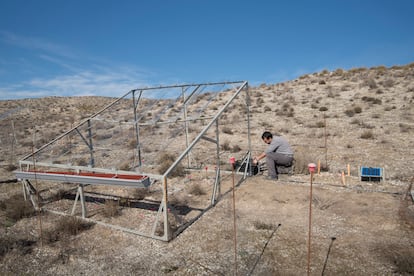This is how aridity creeps into half of the Earth's surface.

It all began in 1996, when rainfall was lower than in previous years. Rainfall did not recover in 1997, 1998, or 1999. In fact, it continued to decline, and in 2006, a decade later, it reached a historic low. In Australia, it is known as the Millennium Drought , and it was the episode of greatest water stress since Europeans arrived on the continent. Cotton production, for example, fell by almost 70%. In Melbourne, the capital of the most affected state, which used to drink from reservoirs, they had to recycle wastewater and install desalination plants. For scientists, it was a type of drought that previously occurred every century and is now more frequent, fueled by climate change: events as long as they last, they can compromise the stability of an entire society or ecosystem. Now, a global experiment has analyzed how critical ecosystems respond to extreme, long-term drought.
The journal Science publishes the results of four years of manipulating the amount of rainfall on hundreds of plots located in 74 ecosystems around the world. They have placed them in grassland, scrub, or shrub ecosystems such as the plains of the American Midwest, the Argentine pampas, the Mediterranean coast, the meadows of Central Europe, and the Siberian steppe. These types of ecosystems cover 45% of the Earth's surface, sequester 30% of its carbon, and are vital for both livestock and agriculture, as well as for countless species. The project, sponsored by Colorado State University, involves more than 170 scientists from 100 institutions. It has been called the International Drought Experiment (IDE). Nothing like it has ever been conducted before.
“In drought treatment, we place transparent methacrylate gutters on the plots that partially intercept rainfall,” explains Romà Ogaya, a researcher at the CREAF-CSIC Global Ecology Unit and head of the IDE installed in El Garraf, in the province of Barcelona. The area is typical of Mediterranean scrubland, and they have been studying the impact of water restriction on primary production—that is, on vegetation—there since 1999. The objective of the experiment is to force the ecosystem's response to a drought so severe and extreme that it only occurs once every hundred years. In this case, they prevent 40% of the rainfall from reaching the soil, “which is equivalent to an 18% reduction in soil moisture, which is what models predict for the coming decades due to climate change,” explains Ogaya.
Colorado State University biologist Melinda Smith leads the IDE and coordinates the experiment. The most extreme event is determined for each site based on the average annual rainfall in the historical record, looking for the driest year in a century. “While historically this magnitude occurred statistically once every 100 years, with climate change, these types of events are expected to occur more frequently, although the frequency varies by site,” says Smith, first author of the study.
The variability of responses is the first result of this research. Ecosystems are so diverse (from the Serengeti savannah to the Siberian permafrost) that they respond differently to drought. The grasslands of the Pyrenees, for example, withstand water restriction well. There, the Pyrenean Institute of Ecology (IPE-CSIC) maintained several plots that participated in the study. Although they also restricted them by 40%, they were unable to reproduce an extreme drought in the first three years due to abundant rainfall. Only in the fourth and final year of the experiment did they achieve this.
“It's a mountainous area, with wet pastures normally maintained by human livestock activity, at the end of the gradient of the ecosystems we studied,” says Yolanda Pueyo, senior scientist at IPE and leader of the experiment in the Pyrenees. There, after three years of moderate drought and one of extreme drought, “we didn't detect a decline in primary productivity, but we did see differences depending on the species; for example, the biomass of legumes did decrease, although the overall biomass did not,” Pueyo emphasizes.
But the Pyrenees site is at the wettest end of the sample. Across the 74 sites, they found that, overall, just one year of extreme drought is enough to wreak havoc: on average, primary production is reduced by 29%. From these levels, in the absence of extreme drought, the ecosystem acclimatizes, as if getting used to scarcity. Things change if the drought is prolonged. What they observed is that after the third year of extreme water stress, the loss of greenery rises to an average of 77%. Not only is the quantity of greenery reduced, but so is its quality, with a decrease in species diversity. This also affects other basic elements of the ecosystem, such as the biological crust and soil nutrients.
One of the most marked transformations occurred at the El Espartal farm in Ciempozuelos. Located in the most arid area of the Community of Madrid, they have been conducting experiments there for 10 years, forcing extreme droughts, like the Millennium drought in Australia. “Ciempozuelos has some rather unusual circumstances,” says Ana M. Sánchez, from the Global Change Research Institute at the Rey Juan Carlos University and leader of the study at El Espartal. In addition to being in a semi-arid area, “the soil is gypsum, and gypsum is a salt,” Sánchez recalls. It is a highly saline substrate, and when it rains, the salt dissolves almost into brine. “We find ourselves with a much higher salt concentration than plant cells have in their tissue. Therefore, the natural tendency is to lose water. In the few moments when there is water, the plant has to invent ways to prevent it from escaping,” she explains.
Under the methacrylate, it rains 45% less, but it was assumed that since plants are accustomed to such an extreme environment, they would pass the test. "But by consistently maintaining the drought, what we've been observing is a reduction in recruitment," explains Sánchez. The annual rhythm of these landscapes begins in autumn, when seeds germinate, flower, and turn green with the spring rains, and wither in summer, leaving new seeds beneath the yellow dryness so that the cycle can begin again next autumn. "We're seeing fewer and fewer of them; the adult individuals are dying, and there's no replacement," he concludes.

There is a fourth site in Spain involved in the experiment. It is in Ayora, southwest of Valencia. “In addition to the control treatment and the extreme exclusion (80% exclusion), we have an intermediate exclusion (-40% precipitation) and another irrigation treatment at specific times in the summer. This allows us to maintain a gradient of water availability at all times, even in the driest years,” explains Alejandro Valdecantos, a researcher at the University of Alicante and head of the IDE.
Despite having spent almost nine years thwarting the fall of rain, they haven't observed a reduction in primary production or a decline in diversity. "It's a very resilient ecosystem. Mediterranean ecosystems are the ones that best withstand such extreme droughts," he explains. That doesn't mean the Ayora scrublands are immune. They have observed alterations in important ecological processes such as root growth, the decomposition of organic matter, and the decomposition of leaf litter, which makes nutrients available to plants again. "We fear that at some point it will collapse," Valdecantos concludes.
Fernando T. Maestre is one of the world's leading experts on arid ecosystems and desertification processes . The researcher at King Abdullah University of Science and Technology (Saudi Arabia) highlights the importance of primary production: it is the basis of all life in terrestrial ecosystems: “It is the energy that plants capture from the sun and transform into organic matter. If an ecosystem loses part of that production—for example, during a drought—the entire ecological chain suffers. There is less food and habitat for herbivores, soils lose carbon and fertility, and ecosystems store less CO₂, which also affects the climate.” For Maestre, also co-author of the Science study, the work shows that if the drought is moderate, many ecosystems manage to acclimatize. “But if the drought is extreme and prolonged, the ecosystem does not recover, but rather progressively degrades.”
What happens if an extreme drought lasts longer than the four years limited to the International Drought Experiment? Smith, the international project leader, recalls the case of a site in her home state of Colorado: “We observed desertification, with a 98% reduction in aboveground biomass, the death of perennial grasses, a drastic reduction in root biomass, and significant alteration in soil structure. Even after three years of recovery, perennial grasses still haven't reestablished themselves.” Therefore, she concludes, “there is a possibility that these tipping points could be exceeded, with subsequent ecosystem collapse and possible desertification.” And there's no coming back from the desert .
EL PAÍS




